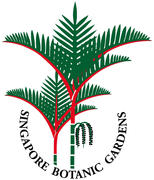Habit:
Herbs; stems creeping or twining at the tips, reaching 2 m in length, longitudinally striate, sparsely pubescent with simple trichomes and 2-3 branched stellate trichomes, 1.5-2 mm in diameter.
Leaves:
Leaves petiolate, palmately divided to the base, the leaflets 3-5, petiolulate, the petioles cylindrical, striate, stellate pubescent, 13-30 mm long, with a sulcus on the upper side, the petiolules sulcate also, pubescent as the petioles, 4-6 mm long, the leaflets ovate-lanceolate, sparsely stellate to glabrous, with the nerves sunken above and prominent below, the lower blade surface stellate or with numerous round blackish dots, leaflets entire, basally decurrent on the petiolules, margins slighty revolute, apically obtuse to acute, mucronulate, 40-77 mm long, 16-29 mm wide, with the median leaflet the largest.
Inflorescences:
Inflorescences axillary, 2-3 flowered, cymose, sometimes with two secondary dichasia arising from the same axil, the rachis faintly striate, sparsely pubescent, exceeding the subtending petiole, 55-65 mm long, distally the rachis bears a fleshy lobe or ring which surrounds the bases of the two peduncles attached to it, each peduncle nearly glabrous, 13-15 mm long, terminating in a pair of unequal bracts, one of the bracts attached higher than the other, these scale-like, with a median ridge on the outer surface, mucronate or terminating in a fleshy spur, edges membranaceous, 1-2.5 mm long; pedicels smooth, clavate, glabrous except for a few trichomes at the level of the bracts, 17-22 mm long;
Flowers:
Sepals unequal, the outer two orbiculate-obovate, basally rounded, margins membranaceous, apically rounded to faintly emarginate or mucronulate, glabrous, 9-11 mm long, 6-7 mm wide, the inner sepals larger, ovate-lanceolate, basally truncate, entire, membranaceous, apically acute-attenuate, glabrous, 12-18 mm long, 7-8 mm wide; corollas funnelform, glabrous, rose-pink (or white), 40-50 mm long, 30-35 mm wide; stamens 22-25 mm long, the filaments simple, glabrous, the anthers spirally dehiscent at anthesis, 5-7 mm long; the pollen smooth, three colpate; ovary not seen, the style simple, filiform, 20-21 mm long, the stigma 2-globose, 2 mm in diameter.
Pollen:
Pollen smooth, three colpate.
Fruits:
Fruits and seeds unknown.
Seeds:
Fruits and seeds unknown.
Author:
Staples, G.W. & D.F. Austin.



Add new comment